
Amélie Brindamour is a Montreal-based settler artist and art educator, exploring issues related to the natural and urban environment through place-specific projects including installations, participatory performances and electronic art. She is concerned about how system layouts determine contexts of relationships and power, and by subverting their functioning intends on promoting cooperation, randomness and creativity.
Her recent work, In Oscillation, will be exhibited at the McCarthy Art Center, Burlington, US (2019) and Eastern Bloc, Montreal (2020), and benefited from the support of the Canada Council for the Arts. Local and international residencies include La Maison des métiers d’art de Québec (2020), Vermont Studio Center (2018) and Avatar (2018). She holds a Bachelor degree in Visual Arts and a Master in Art Education from Concordia University, and works as an art teacher in various academic and community settings.


La Boulangerie du Terroir – 2016 The Temporary Woodland Postal Service – 2017
1) Exhibition about the Art Hive
The moving of the Art Hive this fall semester was a topic of concern suggested by many students when launching the Museum on Wheels earlier in October. It was therefore the first thematic exhibition to be presented on October 28th, showcasing several significant objects from the room that defined the space, such as the giant letter E, the funny shape polka dots pillow, thank you notes written by students, the first welcome sign, etc. To alleviate sadness among students, who confessed experiencing a feeling of belonging with its former location in the Education building, passersby were invited to take part in a coloring therapy activity where they had the chance to express what the Art Hive meant to them, on an image illustrating the space.
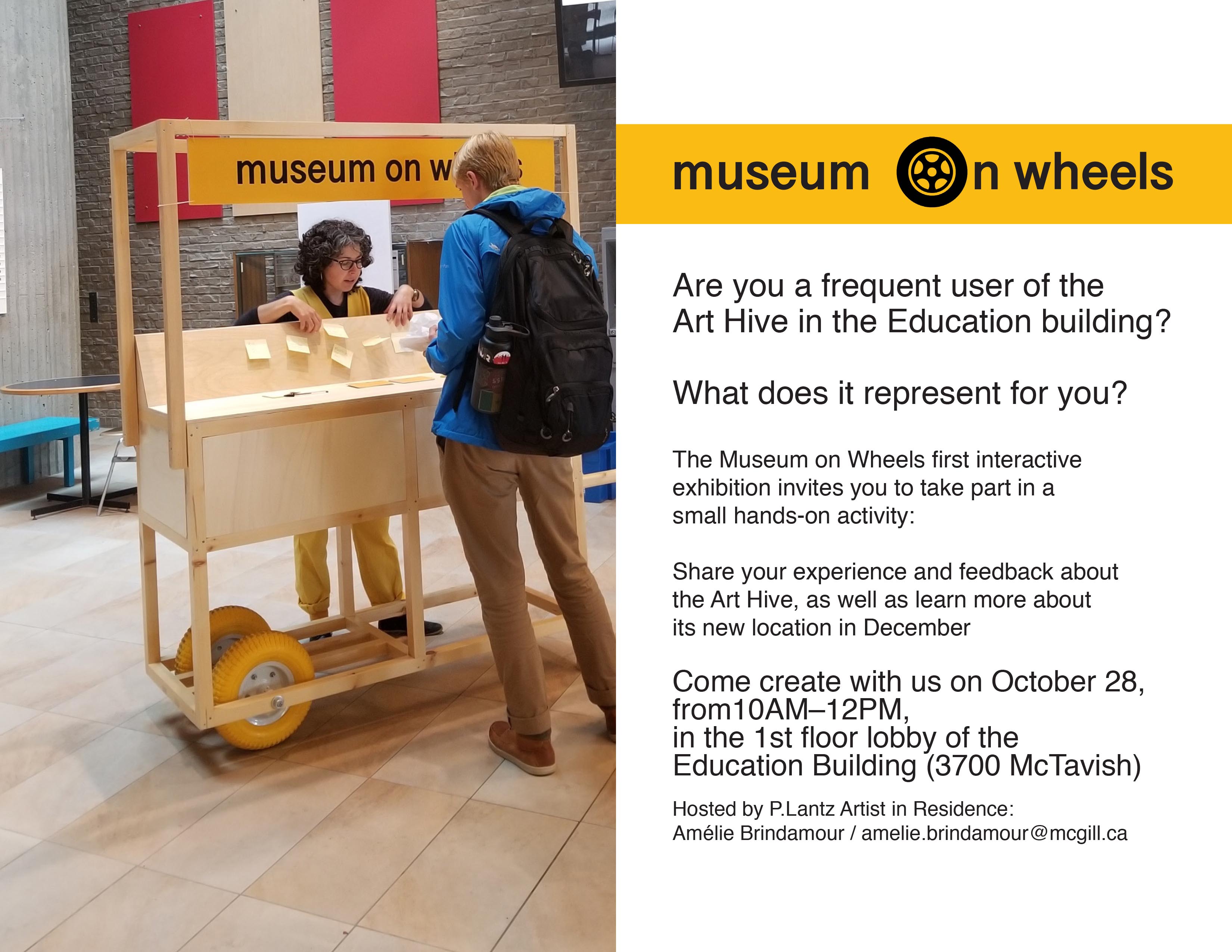
1.1 Promotional poster for October 28th

1.2 Photo by Amélie Brindamour The Museum on Wheels presenting Art Hive artefacts
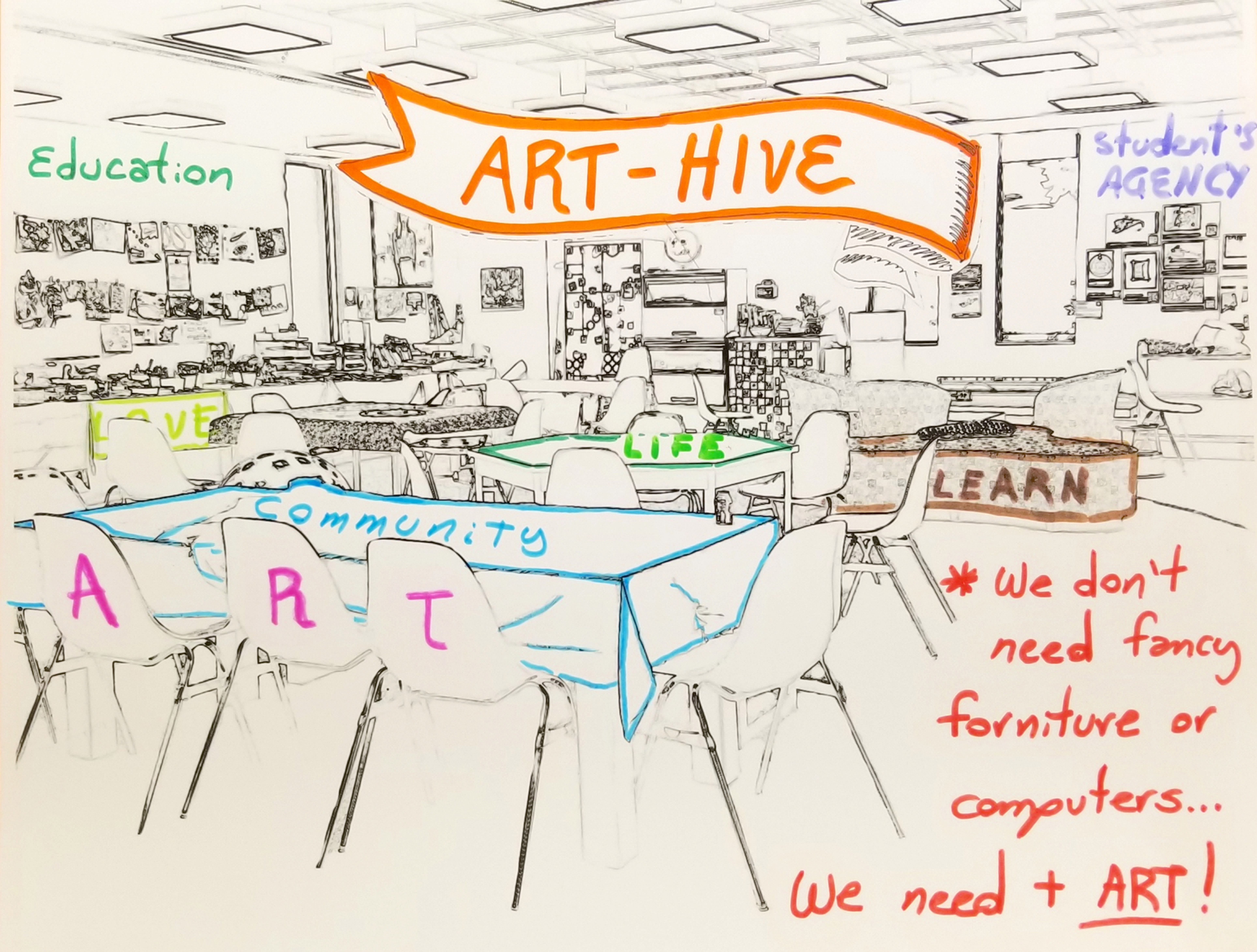


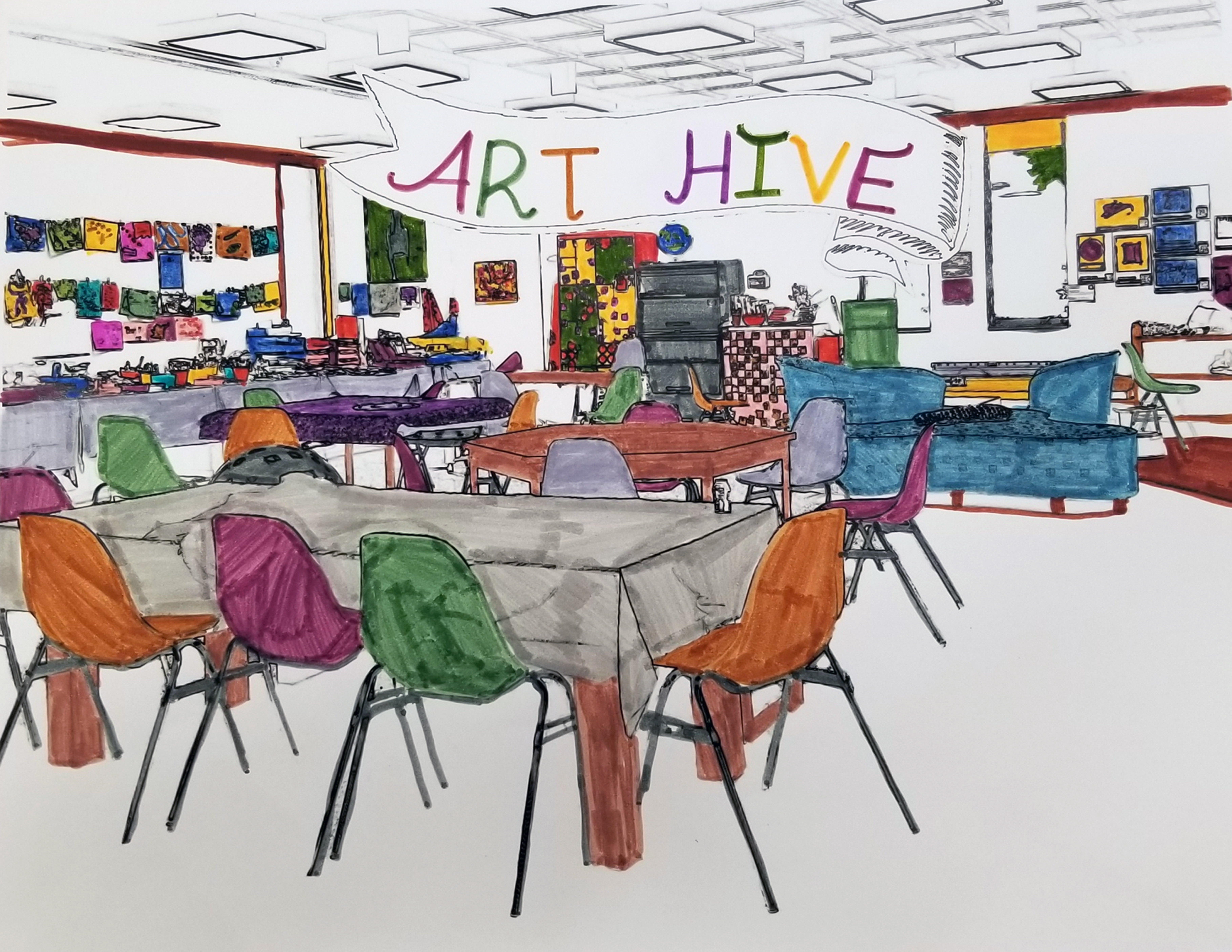

1.3 Artworks created by students during the event
2) Exhibition Students as Social Advocates
On November 22nd, McGill students Stephanie Lung & Janice Yu curated an exhibition with the Museum on Wheels about the role of creativity in political struggles, focussing more specifically on the Hong Kong crisis and students’ implication. Showcasing several digital images, posters and a music video of the Hong Kong orchestra, the two organisers also presented a grid with information on how the conflict transformed students’ daily life, from clothing and dating to worrying for the future. The exhibition was not meant to promote violence, but rather a chance to learn more about the conflict from a student’s perspective through artworks that have been created by them.
The exhibition attracted an average of 75 students, much more than the usual crowd, who wanted to learn more and express their own opinion on the crisis, and it was covered by CBC news. Following some tensions that emerged prior to and during the event, a discussion was organised one week after, hosted by the P. Lantz artist in residence Amélie Brindamour, to give the opportunity to students who were against Hong Kong students’ protests to share their viewpoints.

2.1 Promotional poster for November 22nd

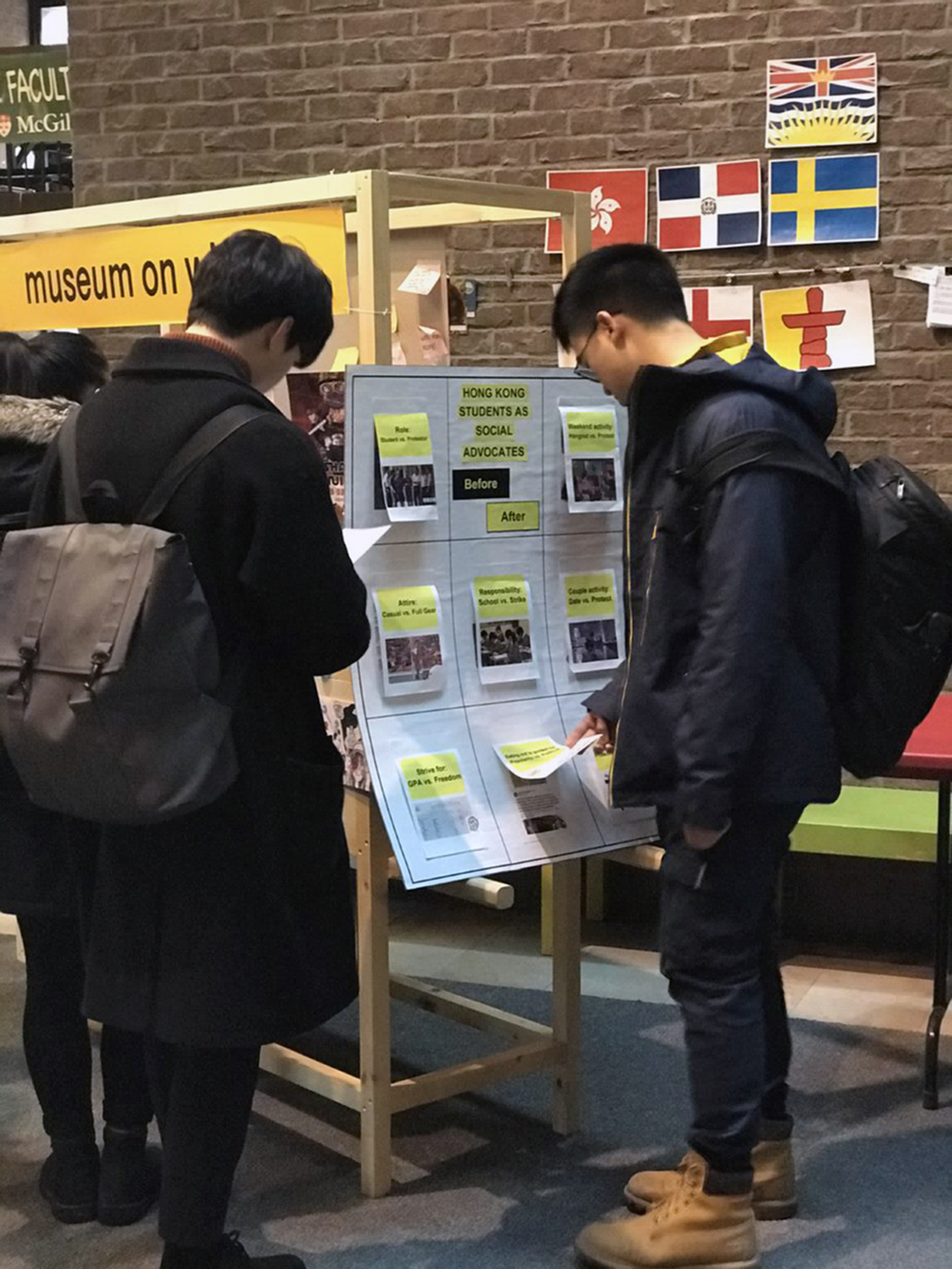

2.2, 2.3 & 2.4 Photos by Amélie Brindamour
Documentation of the event on November 22nd, and small Lennon wall with messages from McGill students to Honk Kong students.
3) Exhibition What’s in a Design?
On February 5th and 6th McGill student Vanessa Gold from the Education Graduate Students’ Society and The Museum on Wheels curated a community consultation exhibition regarding the future transformation of two spaces located on the 6th floor of the Education building. Using two small scale models of each spaces, students were invited to choose how to arrange the handmade furniture provided, or make their own with the materials available, and express their opinion on how to improve those spaces to make them more efficient, friendly and comfortable. Comments were also gathered verbally and on post-it notes. The two areas on the 6th floor will be updated by EGSS by the spring of 2020.

3.1 Promotional poster for February 5th and 6th 2020


3.2 & 3.3 Photos by Amélie Brindamour
Documentation of the event and small on scale model of space on the 6th floor.
4) Exhibition Unable unwilling to connect to the Internet
On January 1st 2020, McGill student Aron Rosenberg started a yearlong challenge to live completely offline, as a way to gain insight for his thesis research on the impact of the internet in the classroom. In collaboration with the Museum on Wheels, he curated an exhibition on February 11th showcasing visual representations of the internet inspired by French artist Louise Drulhe; the internet slope; the mirroring effect of search engines; the physical reality of the internet, the “outernet”; and the multi-shapes of the internet around the world.
Aron performed as well in an AMA session (Ask Me Anything) inspired by the social platform Reddit, in which students could ask whatever questions coming to their mind related to his life without internet. The most popular question was “how do you feel”, but students also expressed concerns about how he would contact his relatives if they lived in another country, and how he was able as a student to communicate with professors.

4.1 Promotional poster for February 11th 2020


4.2 & 4.3 Photos by Amélie Brindamour
Documentation of the event and interactions with students
5) Exhibition In Oscillation, at McCarthy Art Gallery, Vermont
P. Lantz artist in residence Amélie Brindamour presented in November 2019 an exhibition at the McCarthy Art Gallery of Saint Michael’s College:
https://knightsite.smcvt.edu/mccarthygallery/current-exhibitions-2
In Oscillation intends on visually materializing the mycorrhizal network, looking closer to how we could find inspiration from intelligent systems in nature, in order to alleviate the context of power dynamics in our contemporary communication systems. Mycorrhizae are constituted of mycelium (fungi filaments), who come into contact with roots of more that 90% of plants, in order to exchange information and resources.
The title references both the movement of the mycelium (forming the mycorrhizae) expanding in the soil to connect with plants’ roots, and the succession of charge and discharge currents going through an electrical circuit. Non-programmable electronic circuits are used in the installation, some based on Forest Mim’s Engineer’s notebooks circuits from the 80s, in order to mimic the biochemical signals transmitted by the mycorrhiza network. Visitors are invited to hold between their fingers the pressure sensitive sensors to turn on the fungi lighting circuit, that then activate the sound circuits containing light sensitive sensors. The molded resin mushrooms sculptures were made in 2018 from a variety of mycorrhizal fungi at the Bamfield Marine Science Centre (BC, Canada).
This project benefited from a Canada Council for the Arts research and creation grant and the support of LOJIQ (Les Offices jeunesses internationaux du Québec) for a travel grant.
Documentation of the exhibition at the McCarthy Art Gallery, Vermont

5.1 Photo by Sarah Audsley


5.2 &5.3 Photos by Philip Robbins

5.4 Photo by Sarah E. Carlson-McNally
Looking back at my year as a P.Lantz AIR:
I have taken part in artist residencies in unusual places; an off-the-grid island in Nova Scotia; a temporary camping ground in a rural maritime village; a nature centre in the Okanagan Valley; etc. McGill University was not that much different, in that there was no official studio space, nor gallery, or a willing audience. Art was part of the university life, where it was not always expected, and adapting to changes was key, such as the relocation of the Art Hive outside the Education building.
The project that I initially proposed, a mobile exhibition platform called The Museum on Wheels, shaped itself over the course of the residency. Presented in the lobby of the first floor, like all other exhibitions afterwards, my first two events were meant to take the pulse of the McGill community. During the launch of the project I had the chance to meet with the first student with who I collaborated after on an exhibition in November, along with another student who joined us later. The richness of our exchanges while planning for the exhibition – I learned more about the Hong Kong crisis, and the two students gained a better understanding on how exhibition design influences public interactions – as well as the popularity of the event, convinced me to continue in this collaborative direction. Fate led me to meet with the two students who played the role of team curators for the following exhibitions, EGS co-president Vanessa Gold, and Aron Rosenberg. While working together on the same project, each of us shared our specific abilities and academic trainings, which was a very enlightening in terms of breaking the typical barriers of our respective fields. Both were graduate students, and the challenge to represent their research visually, as well as discuss about it with a diverse body of students, was an opportunity to rethink certain aspects of their topic. Some visual materials that we developed together have been integrated later as part of their work.
Working along the other artist in residence, Nadia Moss, provided another layer of collaboration and positive influence to the residency, and I benefited from her past involvement with grassroots organizations, as well as her easiness to connect with students. I also appreciated to have had the occasions to share my project and art practice to students in the Education program as an invited speaker in many courses, possibly expanding their view on how contemporary art could be integrated into the classroom.
With the Covid-19 crisis, the P.Lantz residency ended three weeks earlier, and sent us in the whirlwind of a new reality that we are still processing. Like everyone else, I put a stop on everything that was planned for the spring, and stayed home, reflecting on what I could do as an artist. Part of the answer included making for the first time art workshop videos for youth. Another was participating in Concordia research institute Milieux’s initiative, by sewing mask for caretakers. I am also being reminded more than ever of the value of connections, now that this aspect of our life is limited. On this note, I will now go respond to Aron Rosenberg’s last newsletter, which I received by mail, in which he reflects on his yearlong challenge of being offline, even in this difficult time, and keeps considering the role of the internet in our life.
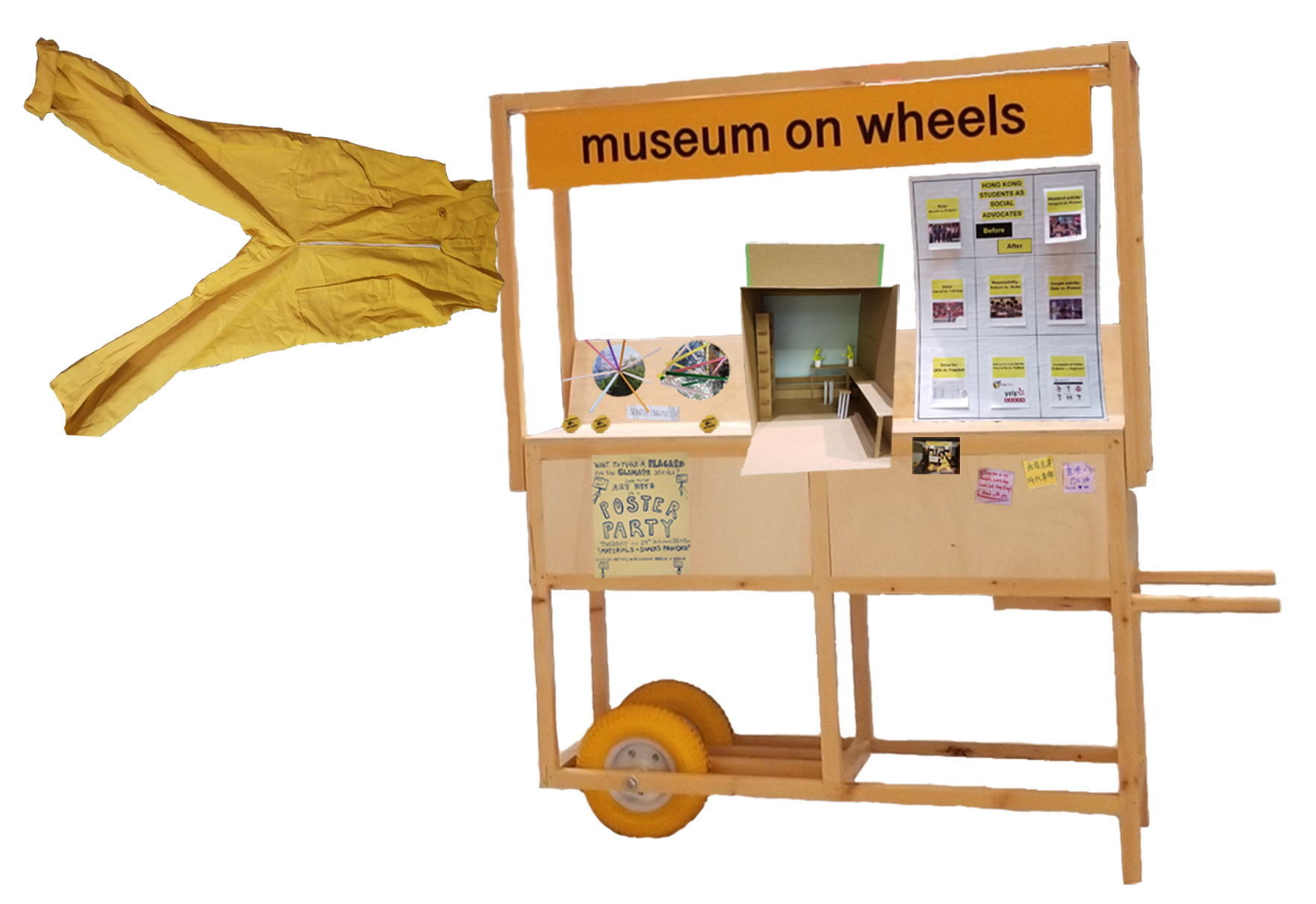
Museum on Wheels archive – digital end of the residency exhibition